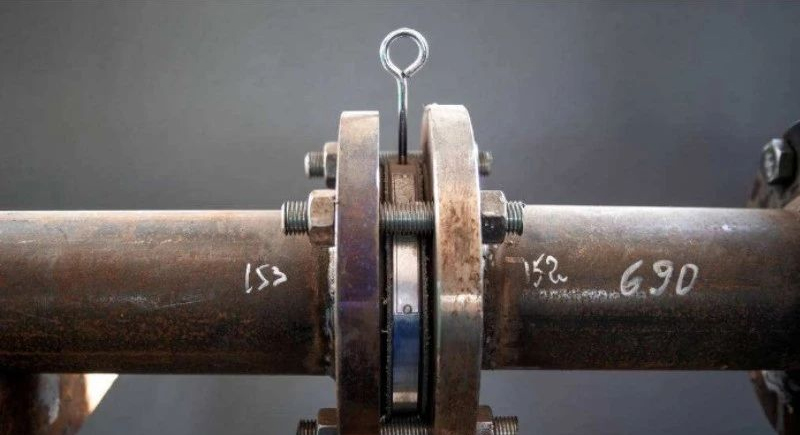VIDEO & CENTER

In the flange joint seal, when the carbon steel or stainless steel flange is equipped with 304 material bolts, leakage problems often occur in the running state. This lecture will make a qualitative analysis of this.

(1) What are the basic differences between 304, 304L, 316 and 316L materials?
304, 304L, 316 and 316L are stainless steel materials commonly used in flange joints, including flanges, sealing elements and fasteners.
304, 304L, 316, and 316L are American Material Standard (ANSI or ASTM) stainless steel designations belonging to the 300 Series of Austenitic stainless steels. The corresponding grades to the domestic material standard (GB/T) are 06Cr19Ni10 (304), 022Cr19Ni10 (304L), 06Cr17Ni12Mo2 (316), 022Cr17Ni12Mo2 (316L). This type of stainless steel is usually referred to as 18-8 stainless steel.
304, 304L, 316 and 316L due to the addition of alloying elements and the amount of different, their physical, chemical and mechanical properties are different, compared with ordinary stainless steel, they have good corrosion resistance, heat resistance and processing properties. The corrosion resistance of 304L is similar to that of 304, but because the carbon content of 304L is lower than that of 304, its intergranular corrosion resistance is stronger. 316, 316L is molybdenum containing stainless steel, due to the addition of molybdenum element, so its corrosion resistance and heat resistance than 304, 304L is better. Similarly, because the carbon content of 316L is lower than that of 316, its crystal corrosion resistance is better. The mechanical strength of 304, 304L, 316 and 316L austenitic stainless steels is low, and the yield strength of 304 is 205MPa at room temperature, and 304L is 170MPa. The yield strength of 316 at room temperature is 210MPa and that of 316L is 200MPa. Therefore, the bolts made of them belong to the low strength class of bolts.
(2) Why should the flange joint not use bolts of 304 and 316 materials?
As mentioned earlier, the flange joint is due to the internal pressure action to separate the sealing surface of the two flanges, causing the gasket stress to decrease accordingly, and the second is due to the creep relaxation of the gasket at high temperature or the bolt itself caused by the creep of the bolt force relaxation, which also causes the gasket stress to decrease, and the flange joint leakage failure.
In actual operation, bolt force relaxation is inevitable, and the bolt force of initial tightening always drops with time. Especially in the flange joint under high temperature and intense cycle conditions, after 10,000 hours of operation, the bolt load loss often exceeds 50%, and decreases with the continuation of time and the increase of temperature.
When the flange and bolt are different materials, especially when the flange is carbon steel and the bolt is stainless steel, because the thermal expansion coefficient of the bolt and flange material is different, such as the thermal expansion coefficient of stainless steel at 50℃ (16.51×10-5 / ℃) is larger than the thermal expansion coefficient of carbon steel (11.12×10-5 / ℃), the device is heated up. When the expansion of the flange is less than the expansion of the bolt, after the deformation coordination, the reduction of bolt elongation causes the relaxation of bolt force, which may lead to the leakage of the flange joint. Therefore, when the high-temperature equipment flange and pipe flange joint, especially the thermal expansion coefficient of the flange and the bolt material are different, the thermal expansion coefficient of the two materials is similar as far as possible.
It can be seen from (1) that the mechanical strength of 304 and 316 austenitic stainless steel is low, and the yield strength of 304 at room temperature is only 205MPa, and that of 316 is only 210MPa. Therefore, in order to improve the ability of bolt anti-relaxation and anti-fatigue, take measures to improve the installation bolt force, such as the maximum installation bolt force will be discussed in the subsequent forum, the installation bolt stress is required to reach 70% of the yield strength of the bolt material, so it is necessary to improve the strength of the bolt material, the use of high strength or medium strength alloy steel bolt material. It is easy to see that, in addition to cast iron, non-metallic flanges or rubber gaskets, for semi-metal and metal gaskets with higher pressure grades or gasket stress, 304, 316 such low-strength material bolts cannot meet the sealing requirements due to insufficient bolt force.
What needs special attention here is that 304 and 316 have two categories in the United States stainless steel bolt material standard, namely B8 Cl.1 and B8 Cl.2 of 304 and B8M Cl.1 and B8M Cl.2 of 316. Cl.1 is treated with carbide solid solution, while Cl.2 is treated with strain strengthening in addition to solid solution treatment. Although there is no fundamental difference between B8 Cl.2 and B8 Cl.1 in chemical corrosion resistance, the mechanical strength of B8 Cl.2 is significantly improved compared with B8 Cl.1, such as the yield strength of B8 Cl.2 bolt material with a diameter of 3/4 "is 550MPa. The yield strength of all diameters of B8Cl.1 bolt materials is only 205MPa, more than twice the difference between the two. The domestic bolt material standard 06Cr19Ni10(304), 06Cr17Ni12Mo2(316), and B8Cl.1 and B8M Cl.1 equivalent. [Note: The bolt material S30408 in GB/T 150.3 "Pressure Vessel Part III Design" is equivalent to B8 Cl.2; S31608 is equivalent to B8M Cl.1.
In view of the above reasons, GB/T 150.3 and GB/ T38343 "Technical Regulations for Flange joint Installation" stipulate that the usual 304 (B8 Cl.1) and 316 (B8M Cl.1) material bolts for pressure equipment flanges and pipe flanges are not recommended, especially in high temperature and intense cycle conditions. B8 Cl.2(S30408) and B8M Cl.2 should be replaced to avoid low mounting bolt forces.
It is worth noting that when low-strength bolt materials such as 304 and 316 are used, even in the installation stage, the bolt may exceed the yield strength of the material or even break due to the absence of torque control. Naturally, if there is a leak in the pressure test or the start of operation, even if the bolt continues to tighten, the bolt force will not go up and the leak cannot be prevented. In addition, these bolts can not be reused after removal, because the bolts have produced permanent deformation, bolt section size becomes smaller, and then installation is easy to break.














